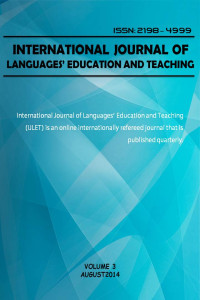Alsagoff, L., McKay, S. L., Hu, G., & Renandya, W. A. (Eds.) (2012). Principles and Practices For Teaching English As An International Language.
Öz
The demographic, geographic, and structural changes to English in the global era have complicated English Language Teaching (ELT, henceforth) and ignited the need to re-examine the traditional lingua-centred ELT assumptions regarding instructional variety, cultural content, the best methodology, the qualifications of the best language teacher, the most appropriate teaching material, assessment, to list just a few. One of the conceptual frameworks as “a pedagogical alternative to conventional Anglo-American English in educational contexts, as a possible option for those who seek a means of expertising themselves in international settings” (Hino, 2012, p. 28) is the paradigm of English as an International Language (EIL, henceforth). This paradigm was originally proposed by Larry Smith in 1976, who brought the attention to the issue by arguing against the internationalisation of native speakers’ cultural norms and voting for denationalising English ownership and revised educational goals to communicate one’s own ideas and culture to others (cited in McKay, 2003). Later, this paradigm attracted several scholars to create various publications with diverse focuses. Principles and practices for teaching English as an international language is one of the recent publications of the EIL paradigm, and what seems to be worth of note is that one of the editors of the book, Sandra Lee McKay, is the one who converted questions regarding traditional ELT assumptions into concrete EIL ideas with the development of EIL Curriculum by her ground-breaking book entitled as Teaching English as an international language: Rethinking goals and approaches in 2002. Therefore, the aim of this book is to foster further understanding of EIL paradigm at not only theoretical but also practical levels.
Alsagoff, L., McKay, S. L., Hu, G., & Renandya, W. A. (Eds.) (2012). Principles and Practices For Teaching English As An International Language.
Öz
The demographic, geographic, and structural changes to English in the global era have complicated English Language Teaching (ELT, henceforth) and ignited the need to re-examine the traditional lingua-centred ELT assumptions regarding instructional variety, cultural content, the best methodology, the qualifications of the best language teacher, the most appropriate teaching material, assessment, to list just a few. One of the conceptual frameworks as “a pedagogical alternative to conventional Anglo-American English in educational contexts, as a possible option for those who seek a means of expertising themselves in international settings” (Hino, 2012, p. 28) is the paradigm of English as an International Language (EIL, henceforth). This paradigm was originally proposed by Larry Smith in 1976, who brought the attention to the issue by arguing against the internationalisation of native speakers’ cultural norms and voting for denationalising English ownership and revised educational goals to communicate one’s own ideas and culture to others (cited in McKay, 2003). Later, this paradigm attracted several scholars to create various publications with diverse focuses. Principles and practices for teaching English as an international language is one of the recent publications of the EIL paradigm, and what seems to be worth of note is that one of the editors of the book, Sandra Lee McKay, is the one who converted questions regarding traditional ELT assumptions into concrete EIL ideas with the development of EIL Curriculum by her ground-breaking book entitled as Teaching English as an international language: Rethinking goals and approaches in 2002. Therefore, the aim of this book is to foster further understanding of EIL paradigm at not only theoretical but also practical levels.
Ayrıntılar
| Birincil Dil | İngilizce |
|---|---|
| Konular | Türk Dili ve Edebiyatı (Diğer) |
| Bölüm | Kitap Tanıtımları |
| Yazarlar | |
| Yayımlanma Tarihi | 30 Ağustos 2014 |
| Yayımlandığı Sayı | Yıl 2014 Cilt: 2 Sayı: 2 |


